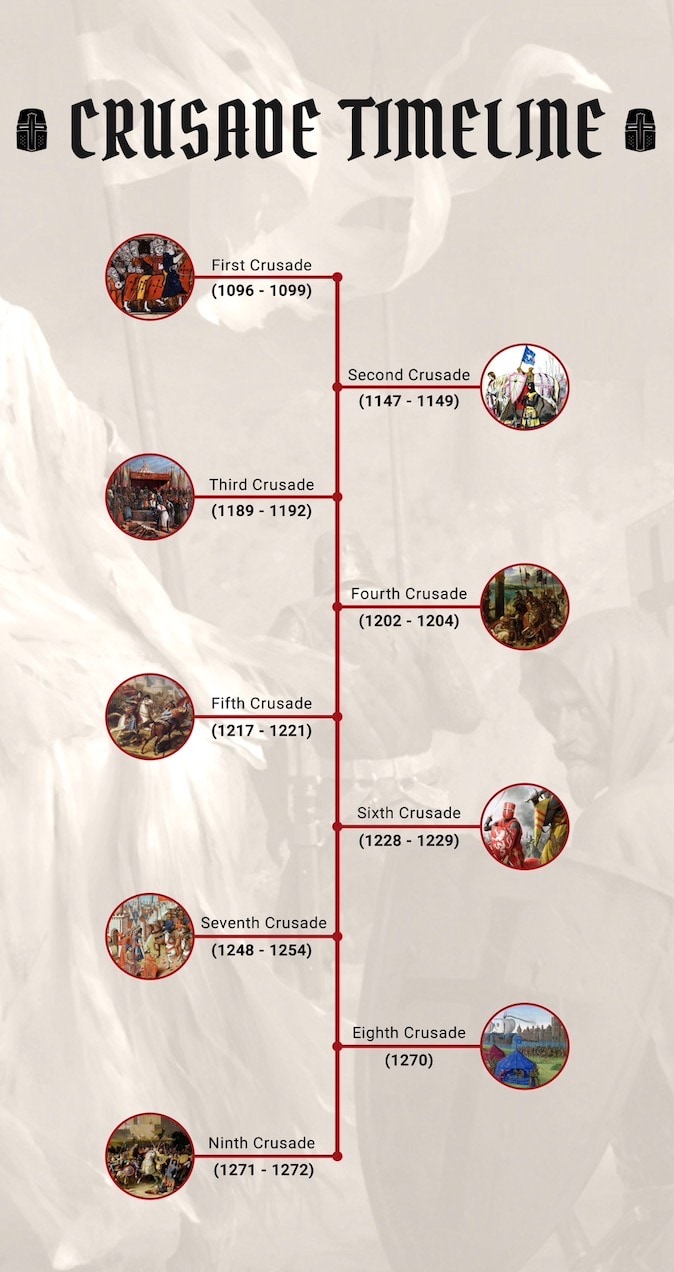Wars, faith, and power all collided in the Crusades. For almost two hundred years, people from across Europe set out to reclaim the Holy Land. Some went for faith. Some went for glory. Others joined just to be part of something bigger. Along the way, battles were won and lost, kingdoms rose and fell, and legends were born.
This timeline will guide you through the major crusades. You’ll see the key battles, meet the leaders, and discover how these wars shaped both Europe and the Middle East for generations. So let's get started!
In this article
Crusades Timeline (1095-1291)
The Crusades were a series of religious wars over the Holy Land, lasting from the 11th to the 13th centuries. The First Crusade began in 1096, and the campaigns continued through the Eighth Crusade in 1270. It all finally ended with the fall of Acre in 1291.
Some events became legendary. The First Crusade captured Jerusalem. The Fourth Crusade took an unexpected turn and went to Constantinople. The Third Crusade brought together famous leaders like Richard the Lionheart and Saladin.
Now, let’s explore the complete Crusades timeline and look at each major event in detail.
The First Crusade (1096-1099)
The First Crusade began when Pope Urban II called on Christians to take back Jerusalem. His words inspired people all over Europe, and many left their homes to join the fight. The journey was long and dangerous, filled with hunger, sickness, and hard battles. Yet the crusaders kept moving, driven by faith and determination.
In 1099, they finally captured Jerusalem from the Muslims. It was a bloody victory, but it gave Christians control of the holy city. This success gave hope for more crusades in the future.
The Second Crusade (1147-1149)
The fall of Edessa in 1144 shocked Christians, who feared Jerusalem might be next. Leaders quickly raised armies and set out with high hopes. At first, it seemed possible, but the crusaders had trouble working together. Their plans fell apart, and many soldiers grew tired and lost confidence.
In the end, they failed to win back any land. Instead, the crusade weakened them even more. People began to question the Church’s power, and faith in the crusading cause started to fade.
The Third Crusade (1189-1192)
Salahudin’s victory at the Battle of Hattin allowed him to take Jerusalem, shocking Europe. Leaders like Richard the Lionheart soon gathered armies to win it back. The crusaders fought bravely and scored some small victories, but Jerusalem itself remained out of reach.
A deal was made instead. Christians were allowed to visit holy places, while Muslims kept control of the city. It was not the victory the crusaders wanted, but it showed that peace talks could sometimes succeed where war did not.
The Fourth Crusade (1202-1204)
The goal of the Fourth Crusade was to capture Egypt and then move on to Jerusalem. But money problems soon changed everything. Owing debts to Venice, the crusaders attacked Constantinople instead. The mission lost its purpose before even reaching the Holy Land.
This choice caused great damage and anger. The crusaders never reached Jerusalem, and the crusade ended in failure. It became a lesson that greed and poor planning could ruin even the most powerful and passionate movements.
The Fifth Crusade (1217-1221)
The Fifth Crusade again targeted Egypt, hoping that controlling it would lead to Jerusalem. At first, things looked bright. The crusaders captured Damietta, and spirits rose high. But then the Nile flooded, supplies ran low, and sickness spread through the camps.
The crusaders could not survive in such conditions. They were forced to surrender Damietta and retreat home. This crusade showed how nature and disease could end a campaign, even when battles seemed to point toward victory at the start.
The Sixth Crusade (1228-1229)
The Sixth Crusade was different from the rest. Emperor Frederick II decided not to fight. Instead, he spoke with Muslim leaders and reached an agreement. Jerusalem was peacefully handed over, with no bloodshed. It was a surprising success, and many people admired his bold approach.
This crusade proved that words could be stronger than weapons. Frederick gained respect for his clever deal, and the campaign stood out as one of the few times peace brought results in the history of the crusades.
The Seventh Crusade (1248-1254)
King Louis IX led the Seventh Crusade with hopes of regaining Jerusalem by attacking Egypt first. At the beginning, the plan seemed strong. But battles turned against the crusaders, and their armies were caught in traps. Louis himself was captured by Muslim forces.
He was later freed after paying a ransom. Although the crusade failed, Louis was respected for his courage and deep faith. His effort showed both the risks of crusading and the strength of leaders who kept fighting for their cause.
The Eighth Crusade (1270)
Still determined, Louis IX launched the Eighth Crusade years later. This time, he chose Tunis in North Africa as a starting point. But the plan quickly fell apart. The heat, sickness, and lack of progress slowed everything down.
Tragedy struck when Louis became ill and died soon after arriving. Without their leader, the crusaders gave up the mission. Nothing was gained, and the crusade ended in failure. People remembered Louis’s devotion, but the campaign itself brought no success at all.
The Ninth Crusade (1291)
The last crusade came with the fall of Arce in 1291. This city was the final Christian stronghold in the Holy Land. When Muslim forces captured it, the crusaders had no base left to fight from. The loss was crushing and final.
After Arce fell, no more serious crusades were launched. Nearly two hundred years of fighting came to an end. The dream of keeping Jerusalem had slipped away, and the age of the crusades closed with a painful defeat.
How to Make a Similar Timeline Using EdrawMax?
The Crusades had so many battles, leaders, and campaigns that it can get confusing. A timeline helps organize everything clearly and makes the history easier to follow. But how do you create a timeline that’s both accurate and visually appealing? The key is to use the right tool.
EdrawMax is a perfect timeline software. It’s simple to use and lets you create professional-looking timelines in minutes. Here’s how you can make your own Crusades timeline using EdrawMax:
Step1
- Start with a Blank Canvas
- Open EdrawMax on your desktop and log in, or register if you’re a new user.
- Click New on the left panel, then choose Blank Drawing to open a new canvas for your Crusades timeline.
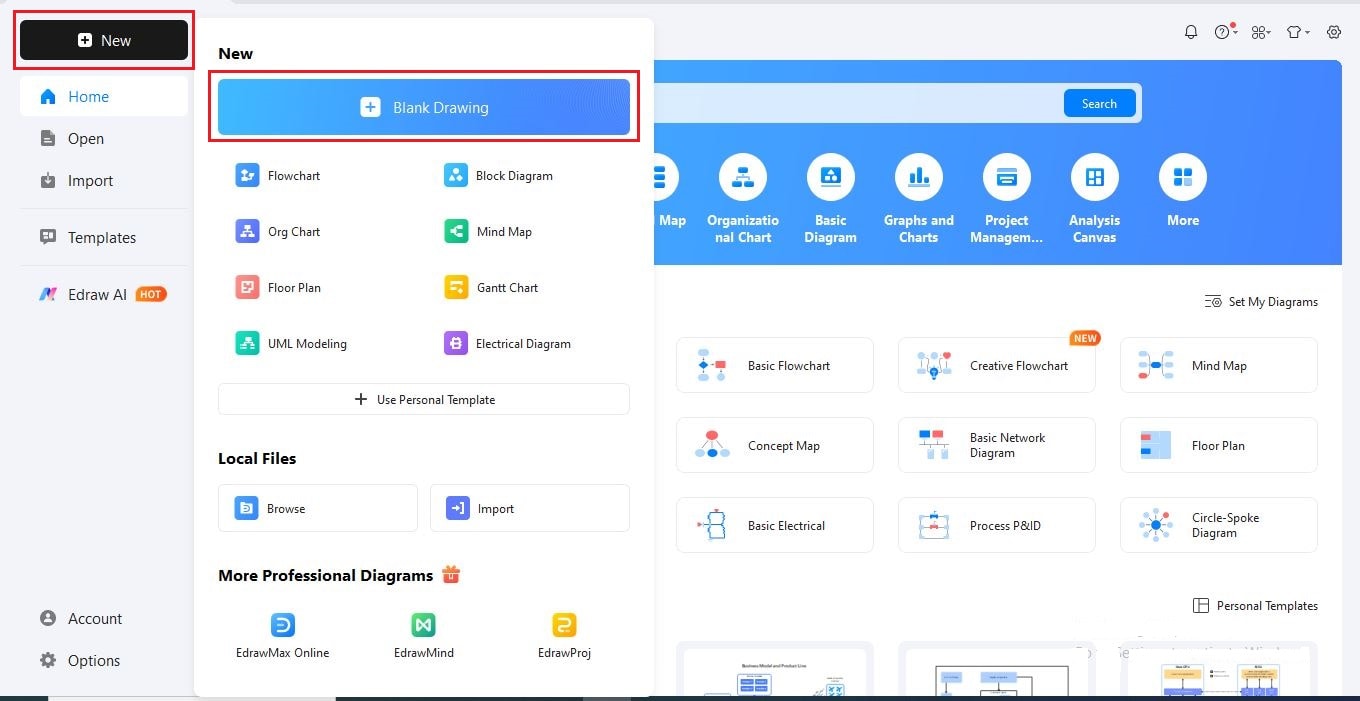
Step2
- Add a Background Image
- Go to the Insert tab and click Picture.
- Choose Local Pictures to upload a background image that fits the medieval theme, such as maps of Europe and the Holy Land.
- Use the Adjust option on the floating toolbar to change brightness, contrast, or transparency so it matches with your design.
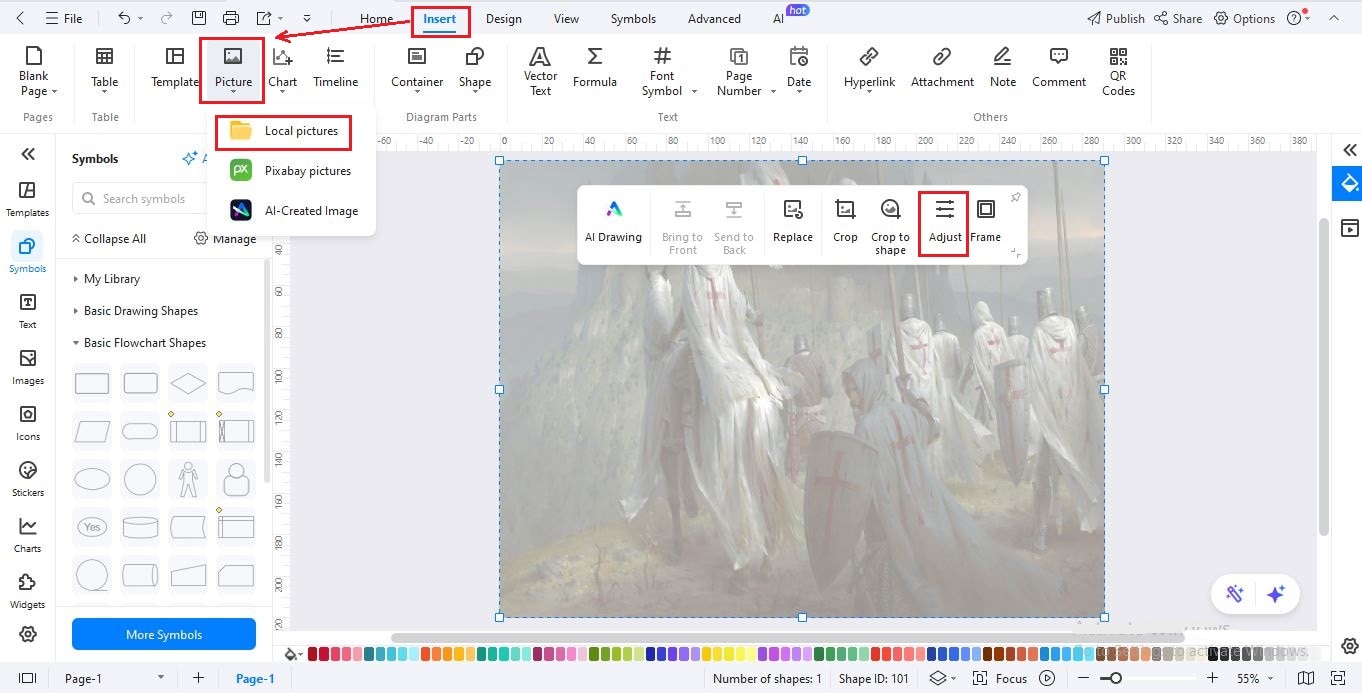
Step3
- Add a Timeline Title
- Add a title like “Crusades Timeline” using text or an image. For this timeline we will use text.
- Click Text and then Click to Add Title to add your heading.
- Optionally, add icons like swords, shields, or medieval banners if you want.
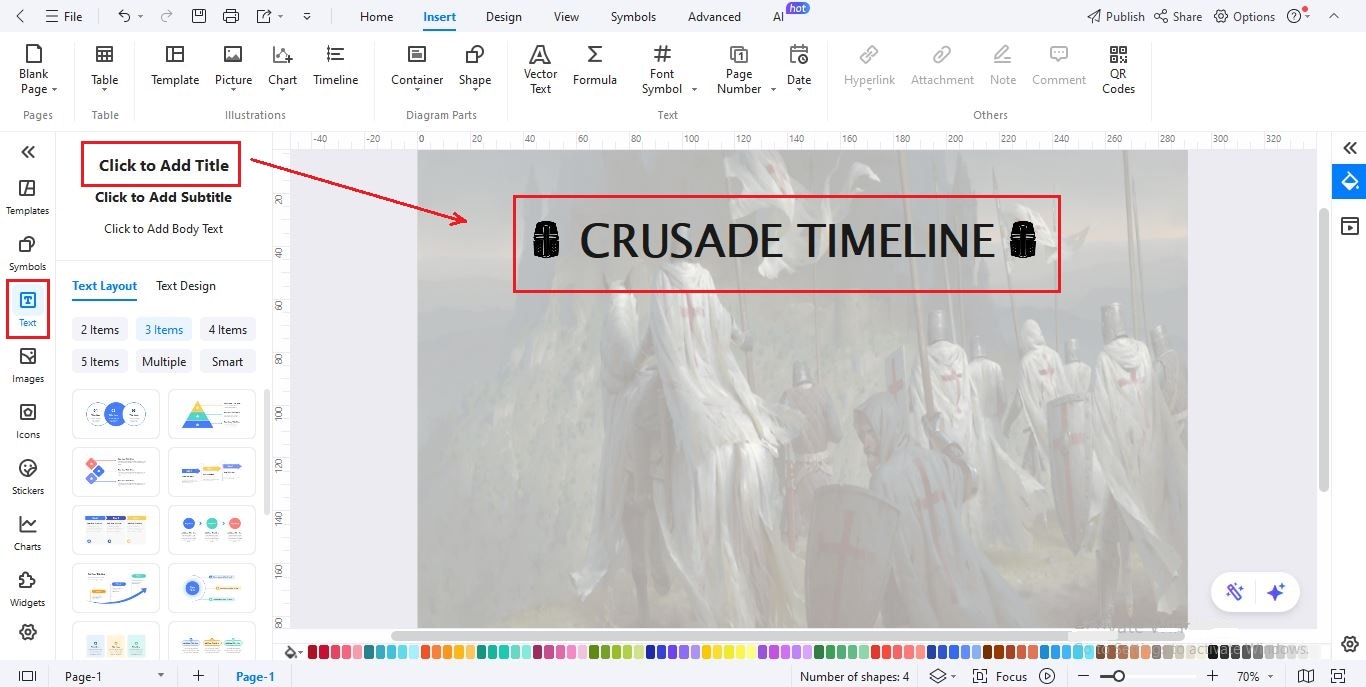
Step4
- Insert the Timeline Layout
- On the top menu, go to Insert and select Timeline.
- Pick a Vertical Timeline with image placeholders, then click OK to add it to your canvas.
- Click on the timeline to open the toolbar and adjust its structure to fit the Crusades’ chronology.
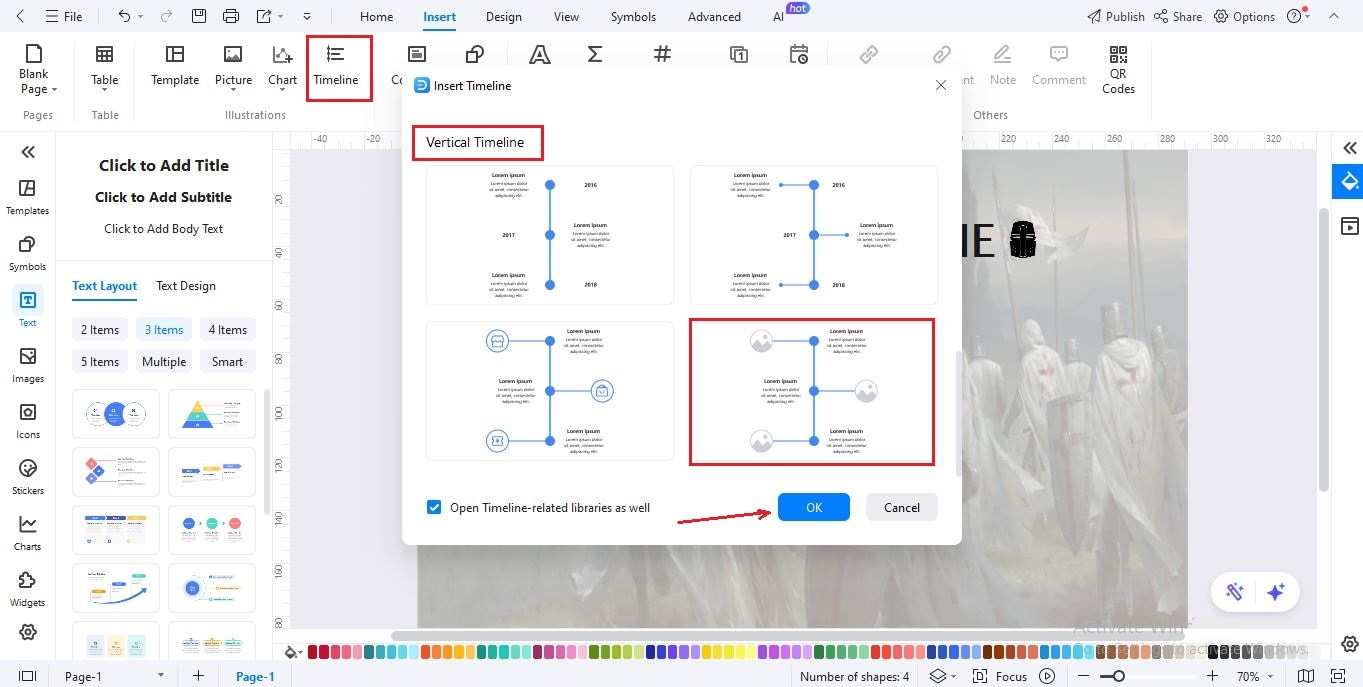
Step5
- Add Key Crusades Events
- Click Text on the left editing panel.
- Use Click to Add Subtitle for each crusade or major battle.
- Then use Click to Add Body to add short descriptions of each campaign, victory, or key leader.
- Continue until your full Crusades history is mapped.
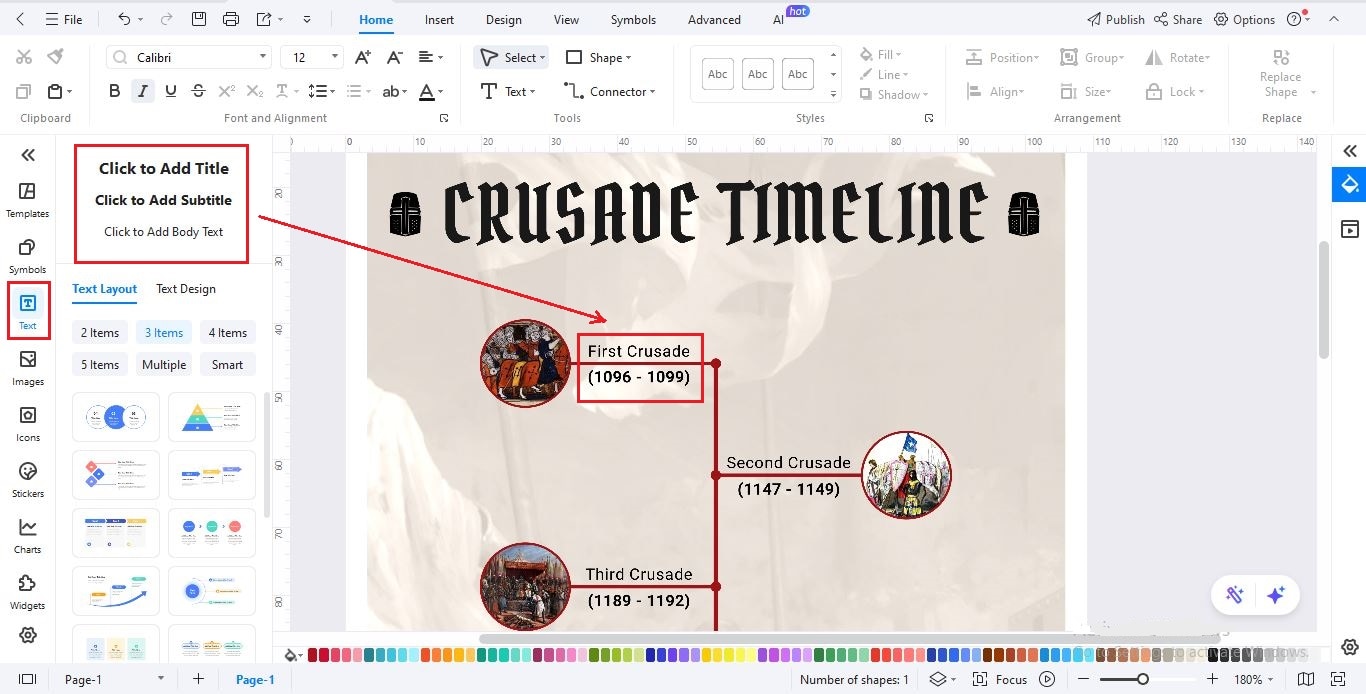
Step6
- Insert Thumbnail Images
- Go to Insert > Picture > Local Pictures and upload images like knights, maps, castles, or flags.
- Click an image, choose Crop to Shape, and select a frame style to match your layout.
- Repeat for each key milestone.
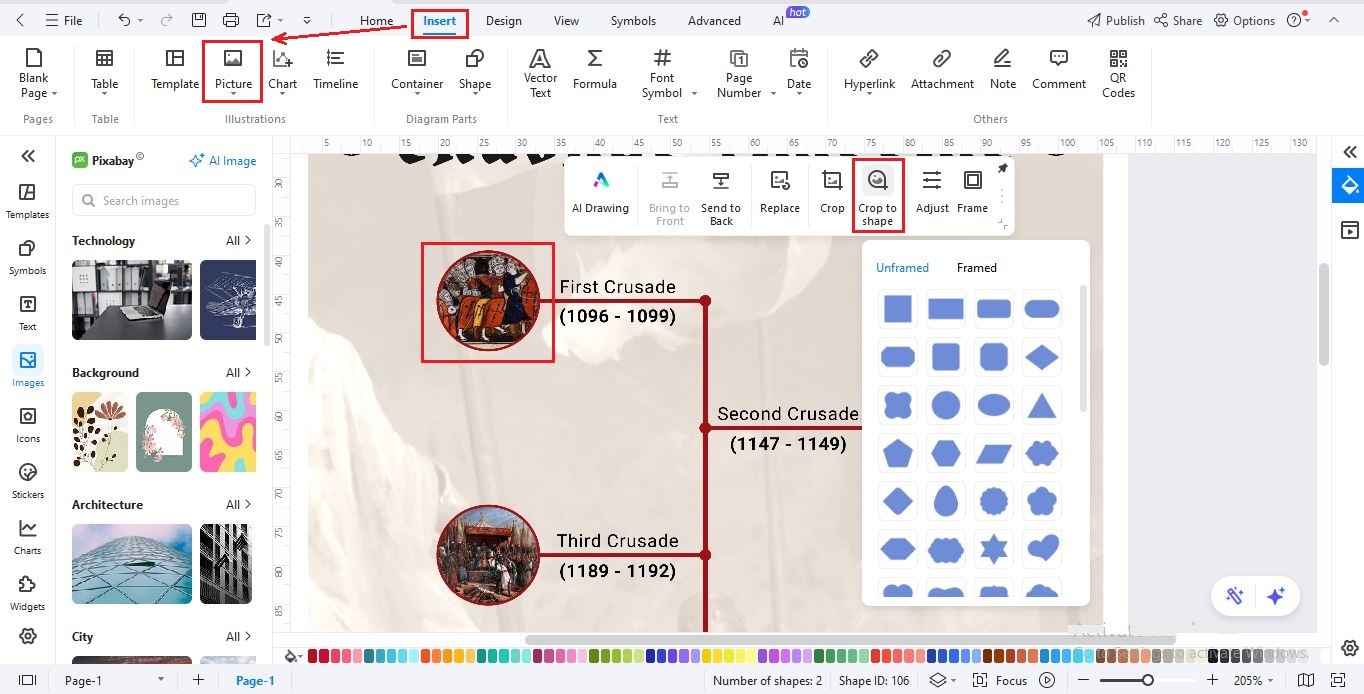
Step7
- Save and Share Your Timeline
- When your timeline is complete, click File > Save to keep an editable version.
- Go to File > Export and choose PNG, PDF, SVG, HTML, Visio, or Excel to share it.
- Click Publish to share your Crusades timeline with the EdrawMax community for inspiration.
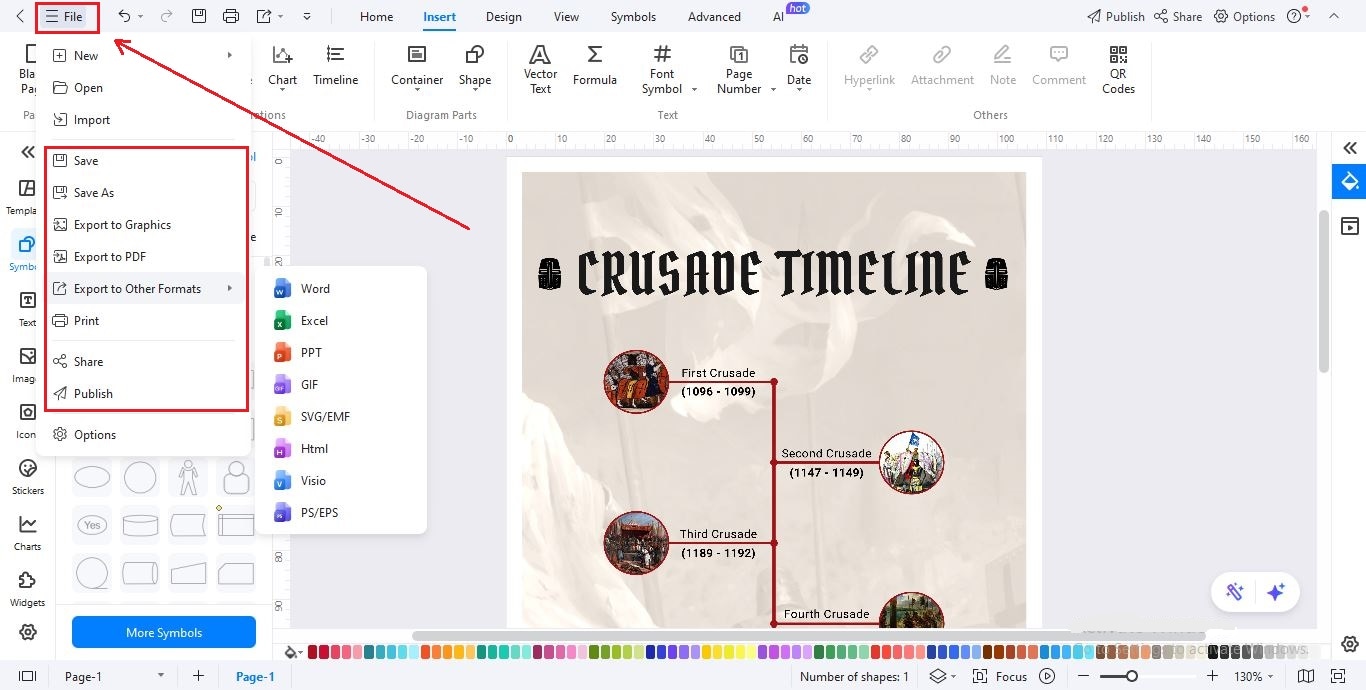
Final Thoughts
The Crusades were long, dramatic, and full of twists. Battles were fought, victories celebrated, and defeats endured. The major campaigns ended in the late 13th century, but their impact lasted for centuries.
If you want to follow the story step by step, EdrawMax is an excellent tool. It helps you create clear visual timelines of events, battles, and leaders, making the Crusades easier to understand.
Try EdrawMax today, and create some engaging timelines for yourself.




